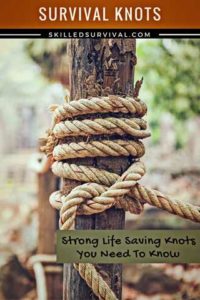 The Survival Knots That Save Lives
The Survival Knots That Save Lives
Whether you’re an avid camper, a determined mountaineer, or a wilderness explorer, there’s one critical skill you need to have in your repertoire.
It’s something you did as a kid for fun, and now it can save your life as an adult – tying knots.
Various expert sources emphasize the same types of knots as lifesavers in outdoor situations.
Today, I want to show you the best survival knots and how to tie them like a pro:
6 Must-Know Survival Knots!
Here are the top survival knots you should master:
- Figure Eight Knot
- Fight Eight on a Bight Knot
- Bowline Knot
- Clove Hitch
- Sheet Bend
- Taut-Line Hitch
Are You Ready For The Tough Times Ahead? Take My 60 Sec Quiz To See If You’re Part Of ‘The Fragile Masses’ Or Not… Start Quiz Now!
1. Figure Eight Knot
A figure-eight knot has three main variations:
- the simple figure eight
- figure-eight follow-through
- figure eight on a bight
The first knot, as the name implies, is a basic figure-eight knot.
The two others add to the original configuration and expand the uses of the knot. This is one of the strongest knots you can tie and maintains up to 85 percent of the rope’s strength.
This means the rope is unlikely to break while you use it.
How to Tie a Figure 8 Knot for Climbing
Drawbacks
The biggest drawback of using the figure-eight knot is that it can be extremely hard to untie. This is especially the case if it has been used repeatedly.
It also uses a lot of rope length. On the other hand, it’s easy to tell if you’ve tied it the wrong way with a quick examination.
Common Mistakes and How to Fix Them
The only real mistake you can make with a figure-eight knot is to add an extra loop to the figure. This is easily spotted by examination, though.
3. Bowline Survival Knot
Like the figure-eight knot, the bowline will hold thousands of pounds of pressure. One difference is that it’s easier to untie after use than a figure eight.
The bowline may be the most dependable of all the survival knots you need to learn. It’s also a versatile knot, with various ways to use it.
How to Tie the Most Useful Knot in the World (Bowline)
Survival Uses
You can tie the bowline around things or through them and tie it around yourself (even one-handed). Tying it with just one hand can be a boon when you need to tie a knot in an emergency.
A bowline knot forms a loop at the end of a rope, and the knot tightens more with any increase in pressure on the loop. That’s why it’s useful for hanging items from tree limbs, like food and survival gear.
Drawbacks
Due to human error, the bowline can’t be depended on when climbing. It’s not terribly difficult to use the bowline incorrectly.
The knot can come untied if the loop is pulled sideways.
Common Mistakes and How to Fix Them
Because the knot can become undone, creating a stopper knot beneath the bowline will increase its safety.
4. Clove Hitch Survival Knot
A hitch is a knot that connects a rope to an object.
The clove hitch is a simple but important survival knot that’s easy to tie.
The benefits you get from it are that it doesn’t loosen or slip, and you can lengthen or shorten the rope without untying the knot.
Clove Hitch Knot
Survival Uses
A clove hitch isn’t as strong as the figure eight or bowline knots, but it’s a good knot to use for anchoring. It will help you fasten a shelter because it stays tight and doesn’t usually slip or loosen.
The clove hitch allows the rope to adjust without untying the knot, making it useful for lowering heavy objects or moving them to a higher spot.
Drawbacks
Constant movement, like the kind caused by a fierce wind, will eventually loosen the knots, causing a shelter to become unstable.
Checking the knots frequently will allow you to adjust and tighten them.
Common Mistakes and How to Fix Them
The clove hitch works best with pressure on the line, so it’s good for keeping a tarp or tent stretched.
Don’t use a clove hitch if the object it’s tied to rotates because the knot could come untied.
5. Sheet Bend Survival Knot
If you need a longer piece of rope than you have available, the sheet bend will allow you to tie shorter pieces of rope together safely.
It works even if the two ropes are dissimilar in size or each is made of a different material.



 The Survival Knots That Save Lives
The Survival Knots That Save Lives